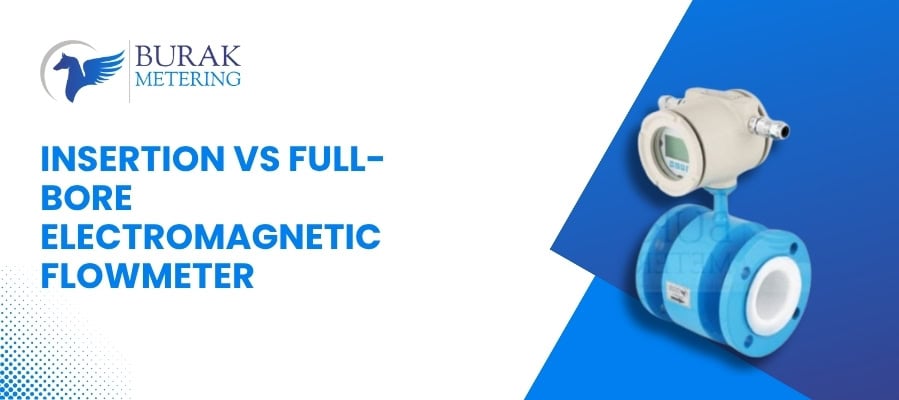 Phone
Phone

Accurate flow measurement defines process reliability in modern industries. Selecting the right electromagnetic flowmeter type directly affects data consistency, equipment uptime, and long-term efficiency.
Among available configurations, insertion and full-bore electromagnetic flowmeters are the two most widely used. Both follow Faraday’s law of electromagnetic induction, yet their designs and installation needs differ significantly.
A full-bore electromagnetic flowmeter, also called an inline mag flow meter, measures the velocity of conductive fluids across the entire pipe cross-section.
It has a fully lined flow tube with electrodes mounted at opposite sides. As the fluid passes through the magnetic field, voltage is induced and converted into a proportional flow signal.
This configuration provides consistent results even under varying flow profiles. Straight pipeline runs upstream and downstream help maintain accuracy.
Full-bore meters are common in:
To understand general characteristics and benefits of mag meters, explore what are electromagnetic flow meters.
An insertion electromagnetic flowmeter uses a probe inserted through the pipe wall. It measures voltage in a portion of the flow and estimates the total flow rate based on that reading.
Unlike inline meters, insertion types do not require replacing a pipe section. For existing or large-diameter lines, this design reduces installation cost and downtime.
Hot-tap fittings allow installation under pressure, making insertion meters ideal for continuous operations or systems where shutdown is difficult.
Full-bore electromagnetic flowmeters measure across the full flow area, producing higher accuracy — typically ±0.2% to ±0.5% of reading. Their readings remain stable even under minor flow disturbances.
Insertion flowmeters have slightly lower accuracy (±1% to ±2%), as results depend on probe position and velocity profile uniformity. However, new designs using multi-electrode probes have significantly improved measurement reliability.
For processes where small variations are acceptable, insertion meters provide reliable data at a lower total cost.
Installing a full-bore mag meter requires pipeline modification, flange preparation, and alignment. It suits new systems or planned maintenance windows.
Insertion meters are faster to install and remove. Using a weld-on or compression fitting, the probe can be placed even while the system is running. This reduces plant downtime and labor.
For correct alignment, grounding, and spacing, always follow Burak’s installation best practices for electromagnetic flow meters.
Both designs have no moving parts, minimizing wear. Insertion types allow easy cleaning and calibration without removing the entire flow section, while full-bore meters may require complete disconnection during service.
Both insertion and full-bore electromagnetic flowmeters cause minimal pressure loss. Full-bore models maintain a smooth inner diameter matching the pipe, while insertion probes extend slightly into the flow.
Even with this extension, the obstruction is negligible. Energy efficiency remains unaffected, making both options suitable for closed-loop process control and utility monitoring.
The economic difference between insertion and full-bore flowmeters grows with pipe size.
Downtime costs also drop sharply when using insertion meters. This makes them ideal for water distribution systems, power plants, and retrofit projects.
Each application should balance accuracy, pipe size, and accessibility before choosing the meter type.
Both designs have long service life due to non-mechanical operation.
Full-bore meters feature protective linings like PTFE or rubber, while insertion probes often use stainless steel or Hastelloy electrodes for durability.
For more details on the material selection of EM flowmeters:
Grounding ensures a stable signal output and noise reduction. Both types require proper grounding rings or electrodes to maintain reading accuracy.
Burak’s service engineers provide site-level verification to confirm correct grounding and cable routing during commissioning.
| Parameter | Full-Bore Electromagnetic Flowmeter | Insertion Electromagnetic Flowmeter |
|---|---|---|
| Measurement Area | Entire pipe cross section | Single or multiple points |
| Accuracy | ±0.2–0.5% | ±1–2% |
| Installation | Requires pipeline modification | Hot-tap or weld-on fitting |
| Maintenance | Full removal | Probe removal only |
| Downtime | High | Minimal |
| Pressure Drop | Negligible | Very low |
| Cost | Higher for large pipes | Lower for large pipes |
| Ideal For | New installations | Retrofitting large pipelines |
The selection depends on project goals and operating conditions. Full-bore models provide superior precision and long-term stability for critical flow monitoring. Insertion meters deliver practical flexibility, quick installation, and economic advantage for large pipes or upgrade projects.
Evaluate flow conditions, conductivity, and accuracy requirements before finalizing the type. For expert selection guidance, contact Burak’s technical team for a project-specific consultation.
Burak Metering is among India’s top gas and liquid flowmeter manufacturers, providing advanced electromagnetic flowmeter solutions across multiple industries.
With decades of engineering experience, we deliver accurate, dependable, and maintenance-friendly meters built for industrial use. Our team supports clients through selection, calibration, and after-sales service to maintain measurement reliability at every stage.
Connect with us today to discuss your process requirements and learn why leading industries rely on Burak flowmeters for consistent performance and technical excellence.